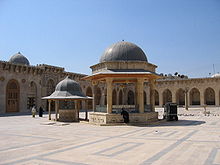Demographics
| Historical populations (in thousands) | ||
|---|---|---|
| Year | Pop. | ±% p.a. |
| 1960 | 4,565 | — |
| 1970 | 6,305 | +3.28% |
| 1981 | 9,046 | +3.34% |
| 1994 | 13,782 | +3.29% |
| 2004 | 17,921 | +2.66% |
| 2014 | 17,952 | +0.02% |
| Source: Population in Syria[150] | ||
Most people live in the Euphrates River valley and along the coastal plain, a fertile strip between the coastal mountains and the desert. Overall population density in Syria is about 99 per km² (258 per square mile). According to the World Refugee Survey 2008, published by the U.S. Committee for Refugees and Immigrants, Syria hosted a population of refugees and asylum seekers numbering approximately 1,852,300. The vast majority of this population was from Iraq (1,300,000), but sizeable populations from the formerPalestine (543,400) and Somalia (5,200) also lived in the country.[151]
In what the UN has described as "the biggest humanitarian emergency of our era",[152]about 9.5 million Syrians, half the population, have been displaced since the outbreak of the Syrian Civil War in March 2011;[153] 3 million are outside the country as refugees.[154]
Ethnic groups
Syrians are an overall indigenous Levantinepeople, closely related to their immediate neighbours, like Lebanese people,Palestinians, Israelis, Iraqis, Maltese andJordanians.[155][156] Syria has a population of approximately 17,951,639 (2014 est.)[3]Syrian Arabs, together with some 500,000Palestinian Arabs, make up roughly 74% of the population (if Syriac Christians are excluded).[138]
The indigenous Christian Syriac-Aramean people and Assyrians are numbered around 400,000 people,[157] with the Syriac-Aramaic group living all over the country, particularly in major urban centers, while the Assyrians mainly reside in the north and northeast (Homs, Aleppo, Qamishli, Hasakah). Many (particularly the Assyrian group) still retain several Akkadianinfused Neo-Aramaic dialects as spoken and written languages, while a small number of Syriac-Arameans still retainWestern Aramaic.[158]
The second largest ethnic group in Syria are The Kurds. They constitute about 9% of the population, or approximately 2 million people.[159] Most Kurds reside in the northeastern corner of Syria and most speak the Kurmanji variant of the Kurdish language.
Syria is also a home to several other ethnic groups mainly the Turkmens (number around 500,000–1,000,000),[160]Circassians (number some 100,000),[161] Greeks,[162] Jews,[163] and Armenians (number approximately 100,000), most arrived during the Armenian Genocide. Syria holds the 7th largest Armenian population in the world. They are mainly gathered in Aleppo, Qamishli, Damascus and Kesab.
The largest concentration of the Syrian diaspora outside the Arab world is in Brazil, which has millions of people of Arab and other Near Eastern ancestries.[164] Brazil is the first country in the Americas to offer humanitarian visas to Syrianrefugees.[165] The majority of Arab Argentines are from either Lebanese or Syrian background.[166]
Religion
Sunni Arabs account for 59–60% of the population, most Kurds (9%) and Turkomen (3%) are Sunni, while 13% are Shia (Alawite, Twelvers, and Ismailis combined),[167]10% Christian[167] (the majority Antiochian Orthodox, the rest including Greek Catholic, Assyrian Church of the East, Armenian Orthodox, Protestants and other denominations), and 3% Druze.[167] Druze number around 500,000, and concentrate mainly in the southern area of Jabal al-Druze.[168]
President Bashar al-Assad's family is Alawite and Alawites dominate the government of Syria and hold key military positions.[169]
Christians (2.5 million), a sizable number of whom are found among Syria's population of Palestinian refugees, are divided into several groups. ChalcedonianAntiochian Orthodox make up 35.7% of the Christian population; the Catholics (Melkite, Armenian Catholic, Syriac Catholic,Maronite, Chaldean Catholic and Latin) make up 26.2%; the Armenian Apostolic Church 10.9%, the Syriac Orthodox make up 22.4%; Assyrian Church of the East and several smaller Christian denominations account the remainder. Many Christianmonasteries also exist. Many Christian Syrians belong to a high socio-economic class.[170]
Languages
Arabic is the official language. Several modern Arabic dialects are used in everyday life, most notably Levantine in the west and Mesopotamian in the northeast. Kurdish (in its Kurmanji form) is widely spoken in the Kurdish regions of Syria.Armenian and Turkish (South Azeri dialect) are spoken among the Armenian and Turkmen minorities.
Aramaic was the lingua franca of the region before the advent of Arabic, and is still spoken among Assyrians, and Classical Syriac is still used as the liturgical language of various Syriac Christian denominations. Most remarkably, Western Neo-Aramaic is still spoken in the village of Ma'loula as well as two neighboring villages, 35 miles (56 km) northeast of Damascus. Many educated Syrians also speak English and French.
Largest cities
| Rank | Name | Province | Pop. | ||||||
|---|---|---|---|---|---|---|---|---|---|
 Aleppo  Damascus | 1 | Aleppo | Aleppo Governorate | 2,132,100 |  Homs  Latakia | ||||
| 2 | Damascus | Damascus | 1,711,000 | ||||||
| 3 | Homs | Homs Governorate | 652,609 | ||||||
| 4 | Latakia | Latakia Governorate | 383,786 | ||||||
| 5 | Hama | Hama Governorate | 312,994 | ||||||
| 6 | Ar-Raqqah | Ar Raqqah Governorate | 220,488 | ||||||
| 7 | Deir ez-Zor | Deir ez-Zor Governorate | 211,857 | ||||||
| 8 | Al-Hasakah | Al-Hasakah Governorate | 188,160 | ||||||
| 9 | Qamishli | Al-Hasakah Governorate | 184,231 | ||||||
| 10 | Sayyidah Zaynab | Rif Dimashq Governorate | 136,427 | ||||||




0 comments:
Post a Comment